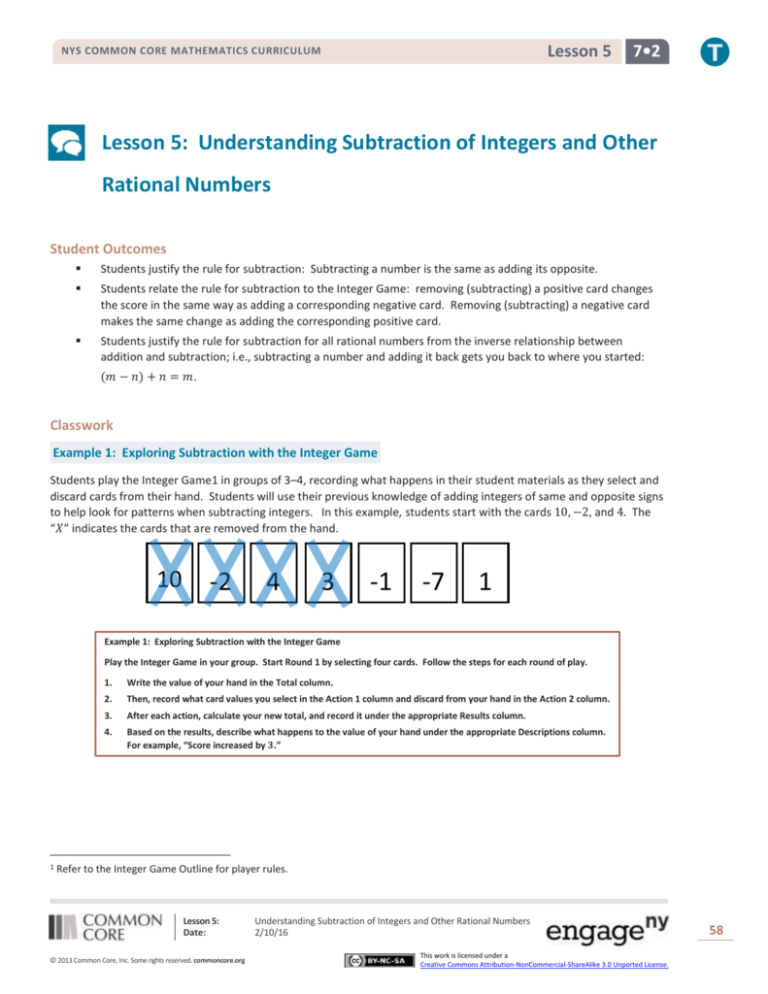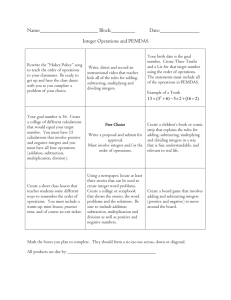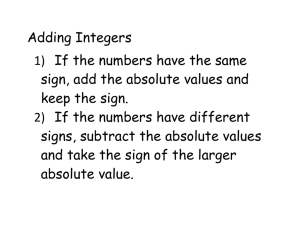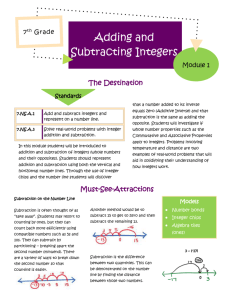
Lesson 5
NYS COMMON CORE MATHEMATICS CURRICULUM
7•2
Lesson 5: Understanding Subtraction of Integers and Other
\
Rational Numbers
Student Outcomes
Students justify the rule for subtraction: Subtracting a number is the same as adding its opposite.
Students relate the rule for subtraction to the Integer Game: removing (subtracting) a positive card changes
the score in the same way as adding a corresponding negative card. Removing (subtracting) a negative card
makes the same change as adding the corresponding positive card.
Students justify the rule for subtraction for all rational numbers from the inverse relationship between
addition and subtraction; i.e., subtracting a number and adding it back gets you back to where you started:
(𝑚 − 𝑛) + 𝑛 = 𝑚.
Classwork
Example 1: Exploring Subtraction with the Integer Game
Students play the Integer Game1 in groups of 3–4, recording what happens in their student materials as they select and
discard cards from their hand. Students will use their previous knowledge of adding integers of same and opposite signs
to help look for patterns when subtracting integers. In this example, students start with the cards 10, −2, and 4. The
“𝑋” indicates the cards that are removed from the hand.
10
-2
4
3
-1
-7
1
0
Example 1: Exploring Subtraction with the Integer Game
Play the Integer Game in your group. Start Round 1 by selecting four cards. Follow the steps for each round of play.
1
1.
Write the value of your hand in the Total column.
2.
Then, record what card values you select in the Action 1 column and discard from your hand in the Action 2 column.
3.
After each action, calculate your new total, and record it under the appropriate Results column.
4.
Based on the results, describe what happens to the value of your hand under the appropriate Descriptions column.
For example, “Score increased by 𝟑.”
Refer to the Integer Game Outline for player rules.
Lesson 5:
Date:
© 2013 Common Core, Inc. Some rights reserved. commoncore.org
Understanding Subtraction of Integers and Other Rational Numbers
2/10/16
This work is licensed under a
Creative Commons Attribution-NonCommercial-ShareAlike 3.0 Unported License.
58
Lesson 5
NYS COMMON CORE MATHEMATICS CURRICULUM
Round
Total
Action 1
Result 1
𝟏
𝟏𝟐
Select 𝟑
𝟏𝟓
𝟐
𝟓
Select −𝟏
𝟒
𝟑
𝟎
Select −𝟕
−𝟕
𝟒
−𝟓
Select 𝟏
−𝟒
𝟓
𝟑
Description
Score (total)
increased by 𝟑
Score (total)
decreased by 𝟏
Score (total)
decreased by 𝟕
Score (total)
increased by 𝟏
Action 2
Result
2
Discard 𝟏𝟎
𝟓
Discard 𝟒
𝟎
Discard −𝟐
−𝟓
Discard −𝟕
𝟑
7•2
Description
Score (total)
decreased by 𝟏𝟎
Score (total)
decreased by 𝟒
Score (total) increased
by 𝟐
Score (total) increased
by 𝟕
Discussion (5 minutes): Making Connections to Integer Subtraction
The teacher leads class in a discussion. The objective of the discussion is to allow students the opportunity to discuss
any patterns they noticed while playing the game, in particular what happens to the value of the hand when cards with
negative values are selected or discarded. The teacher poses questions to individual groups to elicit student feedback.
Scaffolding:
Discussion: Making Connections to Integer Subtraction
1.
How did selecting positive value cards change the value of your hand?
It increased my score by the value of the card.
2.
How did selecting negative value cards change the value of your hand?
It decreased my score by the absolute value of the card.
3.
How did discarding positive value cards change the value of your hand?
It decreased my score by the value of the card.
4.
How did discarding negative value cards change the value of your hand?
It increased my score by the absolute value of the card.
5.
Display questions and give
students time to discuss in
their groups prior to
whole-class discussion.
Allow students to use
whiteboards, number
lines, or tables to
formulate and justify their
opinions to the group.
Record selected student
responses and examples
on chart paper to help
identify patterns.
What operation reflects selecting a card?
Addition
6.
What operation reflects discarding or removing a card?
Subtraction
7.
Based on the game, can you make a prediction about what happens to the result when:
a.
Subtracting a positive integer.
The result of the hand will decrease by the value of the integer.
b.
Subtracting a negative integer.
The result of the hand will increase by the absolute value of the negative integer.
At the end of the lesson, the class will review its predictions.
Lesson 5:
Date:
© 2013 Common Core, Inc. Some rights reserved. commoncore.org
Understanding Subtraction of Integers and Other Rational Numbers
2/10/16
This work is licensed under a
Creative Commons Attribution-NonCommercial-ShareAlike 3.0 Unported License.
59
Lesson 5
NYS COMMON CORE MATHEMATICS CURRICULUM
Example 2 (5 minutes): Subtracting a Positive Number
Scaffolding:
Example 2: Subtracting a Positive Number
a.
7•2
The teacher leads whole class by modeling an Integer Game example to find the sum of 𝟒 + 𝟐
Allow students to use their
Integer Cards throughout
this example.
If I had these two cards, the sum would be 𝟔.
4
2
4 + 2 = 6
2
4
b.
Show that discarding (subtracting) a positive card, which is the same as subtracting a positive number, decreases
the value of the hand.
If I discarded or removed the 𝟐, my score would decrease by 𝟐 because I would still have a 4 left in my hand. 𝟒 +
𝟐 − 𝟐 = 𝟒. Taking away, or subtracting, a 𝟐 causes my score to decrease by 𝟐.
Subtract (remove) the two.
4
2
2
4
4 + 2 − 2 = 4
or
−2
4
2
-2
2
4
4 + 2 + (−2) = 4
Lesson 5:
Date:
© 2013 Common Core, Inc. Some rights reserved. commoncore.org
Understanding Subtraction of Integers and Other Rational Numbers
2/10/16
This work is licensed under a
Creative Commons Attribution-NonCommercial-ShareAlike 3.0 Unported License.
60
Lesson 5
NYS COMMON CORE MATHEMATICS CURRICULUM
7•2
Removing ( subtracting ) a positive card changes the score in the same way as adding a card whose value is the
additive inverse (or opposite). In this case, adding the corresponding negative, such that 𝟔 − 𝟐 = 𝟒 + (−𝟐) .
Subtracting a positive 𝒒-value is represented on the number line as moving to the left on a number line.
Example 3 (7 minutes): Subtracting a Negative Number
The teacher leads whole class by modeling an Integer Game example to find the sum of 4 + (−2).
Example 3: Subtracting a Negative Number
Follow along with the teacher, completing the diagrams below.
4
-2
−2
4 + (−2) = 2
a.
4
How does removing a negative card change the score, or value, of the hand?
If I discarded or removed the −𝟐, my score would increase by 𝟐 because I would still have a 4 left in my hand.
𝟒 + 𝟐 − 𝟐 = 𝟒. Taking away, or subtracting, a −𝟐 causes my score to increase by 𝟐.
4
-2
Subtract (remove) the negative two.
−2
4 + (−2) − (−2) = 4
4
or
4
-2
2
𝟐
−𝟐
4 + (−2) + 2 = 4
Lesson 5:
Date:
© 2013 Common Core, Inc. Some rights reserved. commoncore.org
4
Understanding Subtraction of Integers and Other Rational Numbers
2/10/16
This work is licensed under a
Creative Commons Attribution-NonCommercial-ShareAlike 3.0 Unported License.
61
Lesson 5
NYS COMMON CORE MATHEMATICS CURRICULUM
7•2
Removing ( subtracting ) a negative card changes the score in the same way as adding a card whose value is the
additive inverse (or opposite). In this case, adding the corresponding positive such that 𝟔 − (−𝟐) = 𝟔 + 𝟐.
Subtracting a negative q-value is represented on the number line as moving to the right on a number line because it is the
opposite of subtracting a positive q-value (move to the left).
The Rule of Subtraction: Subtracting a number is the same as adding its additive inverse (or opposite).
Exercises (8 minutes): Subtracting Positive and Negative Integers
Students will work independently to find the differences below. Students may use the number line as additional
support. The teacher should model some examples with the class to help students make the connection between
subtraction and addition of the additive inverse.
To solve the problem −8 − 2
−8 + 2
Step 1:
Change the addition sign to subtraction. (Rule of
Subtraction)
−8 + (−2)
Step 2:
Change the positive 2 to a negative 2. (Rule of
Subtraction)
| − 8| = 8 | − 2| = 2
Steps 3-5: Follow the steps for adding numbers with
opposite signs.
Scaffolding:
Have students circle the
integer with the greater
absolute value to
determine the final sign
of the integer.
8−2 = 6
Subtract the absolute values.
−6
Take the sign of the number with the greater absolute value.
Likewise, to solve the problem 4 − (−2)
4 + 2
Step 1:
Change the addition sign to subtraction and the −2 to 2 (Rule of Subtraction).
4 + 2 = 6
Step 2:
Follow the steps for adding numbers with same signs.
Exercises: Subtracting Positive and Negative Integers
1.
Using the rule of subtraction, rewrite the following subtraction sentences as addition sentences and solve. Use the
number line below if needed.
a.
𝟖−𝟐
𝟖 + (−𝟐) = 𝟔
b.
𝟒−𝟗
𝟒 + (−𝟗) = −𝟓
c.
–𝟑 − 𝟕
−𝟑 + (−𝟕) = −𝟏𝟎
d.
−𝟗 − (−𝟐)
−𝟗 + 𝟐 = −𝟕
Lesson 5:
Date:
© 2013 Common Core, Inc. Some rights reserved. commoncore.org
Understanding Subtraction of Integers and Other Rational Numbers
2/10/16
This work is licensed under a
Creative Commons Attribution-NonCommercial-ShareAlike 3.0 Unported License.
62
Lesson 5
NYS COMMON CORE MATHEMATICS CURRICULUM
2.
7•2
Find the differences.
−𝟐 − (−𝟓)
a.
−𝟐 + 𝟓 = 𝟑
𝟏𝟏 − (−𝟖)
b.
𝟏𝟏 + 𝟖 = 𝟏𝟗
– 𝟏𝟎 − (−𝟒)
c.
−𝟏𝟎 + 𝟒 = −𝟔
3.
Write two equivalent expressions that would represent, “An airplane flies at an altitude of 𝟐𝟓, 𝟎𝟎𝟎 feet. A
submarine dives to depth of 𝟔𝟎𝟎 feet below sea level.”
𝟐𝟓, 𝟎𝟎𝟎 − (−𝟔𝟎𝟎) and 𝟐𝟓, 𝟎𝟎𝟎 + (−𝟔𝟎𝟎).
Closing (3 minutes)
Summarize the rules for integer subtraction by posing the following questions to the class.
Review your predictions made earlier in class. Were you correct? If not, how were your predictions different
from the correct responses?
When playing the Integer Game, give two ways you can increase the value of your hand.
Give two ways you can decrease the value of your hand.
Lesson Summary
The Rule for Subtraction: Subtracting a number is the same as adding its opposite.
Removing (subtracting) a positive card changes the score in the same way as adding a corresponding
negative card.
Removing (subtracting) a negative card makes the same change as adding the corresponding positive
card.
For all rational numbers, subtracting a number and adding it back gets you back to where you started:
(𝒎 − 𝒏) + 𝒏 = 𝒎.
Exit Ticket (7 minutes)
Lesson 5:
Date:
© 2013 Common Core, Inc. Some rights reserved. commoncore.org
Understanding Subtraction of Integers and Other Rational Numbers
2/10/16
This work is licensed under a
Creative Commons Attribution-NonCommercial-ShareAlike 3.0 Unported License.
63
Lesson 5
NYS COMMON CORE MATHEMATICS CURRICULUM
Name ___________________________________________________
7•2
Date____________________
Lesson 5: Understanding Subtraction of Integers and Other
Rational Numbers
Exit Ticket
1.
If a player had the following cards, what is the value of his hand?
1
2.
-7
4
a.
Identify two different ways the player could get to a score of 5 by adding or removing only one card. Explain.
b.
Write two equations for part (a), one for each of the methods you came up with for arriving at a score of 5.
Using the rule of subtraction, rewrite the following subtraction sentences as addition sentences and find the sums.
a.
5− 9
b.
−14 − (−2)
Lesson 5:
Date:
© 2013 Common Core, Inc. Some rights reserved. commoncore.org
Understanding Subtraction of Integers and Other Rational Numbers
2/10/16
This work is licensed under a
Creative Commons Attribution-NonCommercial-ShareAlike 3.0 Unported License.
64
Lesson 5
NYS COMMON CORE MATHEMATICS CURRICULUM
7•2
Exit Ticket Sample Solutions
1.
If a player had the following cards, what is the value of his hand?
The current value of the hand is −𝟐. 𝟏 + (−𝟕) + 𝟒 = −𝟐.
1
a.
-7
4
Identify two different ways the player could get to a score of 𝟓 by adding or removing only one card. Explain.
He could remove the −𝟕 or add 𝟕. If we remove the −𝟕, the value of the hand will be 𝟓, which is 𝟕 larger
than −𝟐. I could also get a sum of 𝟓 by adding 𝟕 to the hand. Therefore, removing the −𝟕 gives me the same
result as adding 𝟕.
b.
Write two equations for part (a), one for each of the methods you came up with for arriving at a score of 𝟓.
−𝟐 − (−𝟕) and – 𝟐 + 𝟕 = 𝟓
2.
Using the rule of subtraction, rewrite the following subtraction sentences as addition sentences and find the sums.
a.
𝟓– 𝟗
𝟓 + (−𝟗) = −𝟒
b.
– 𝟏𝟒 − (−𝟐)
−𝟏𝟒 + 𝟐 = −𝟏𝟐
Problem Set Sample Solutions
The problem set provides students with skill practice and application of the rules for integer subtraction. Students will
solve problems with and without a number line.
1.
On a number line, find the difference of each number and 𝟒? Complete the table to support your answers. The first
example is provided.
Number
𝟏𝟎
𝟐
−𝟒
−𝟔
𝟏
Subtraction Sentence
𝟏𝟎 − 𝟒
𝟐−𝟒
−𝟒 − 𝟒
−𝟔 − 𝟒
𝟏−𝟒
Lesson 5:
Date:
© 2013 Common Core, Inc. Some rights reserved. commoncore.org
Addition Sentence
𝟏𝟎 + (−𝟒)
𝟐 + (−𝟒)
−𝟒 + (−𝟒)
−𝟔 + (−𝟒)
𝟏 + (−𝟒)
Answer
𝟔
−𝟐
−𝟖
−𝟏𝟎
𝟑
Understanding Subtraction of Integers and Other Rational Numbers
2/10/16
This work is licensed under a
Creative Commons Attribution-NonCommercial-ShareAlike 3.0 Unported License.
65
Lesson 5
NYS COMMON CORE MATHEMATICS CURRICULUM
2.
7•2
You and your partner were playing the Integer Game in class. Here are the cards in both hands.
Your hand
-8
a.
6
Your partner’s hand
1
-2
9
-5
2
-7
Find the value of each hand. Who would win based on the current scores? (The score closest to 𝟎 wins.)
My hand: −𝟖 + 𝟔 + 𝟏 + (−𝟐) = −𝟑
Partner’s hand: 𝟗 + (−𝟓) + 𝟐 + (−𝟕) = −𝟏
My partner would win because −𝟏 is closer to 𝟎. It is 𝟏 unit to the left of 𝟎.
b.
Find the value of each hand if you discarded the −𝟐 and selected a 𝟓, and your partner discarded the −𝟓 and
selected a 𝟓. Show your work to support your answer.
My hand: Discard the −𝟐, −𝟑 – (−𝟐) = −𝟏; Select a 𝟓: −𝟏 + 𝟓 = 𝟒.
Partner’s hand: Discard the −𝟓, −𝟏 – (−𝟓) = 𝟒; Select a 𝟓: 𝟒 + 𝟓 = 𝟗.
c.
Use your score values from part (b) to determine who would win the game now.
I would win now because 𝟒 is closer to zero.
3.
Write the following expressions as a single integer.
a.
−𝟐 + 𝟏𝟔
𝟏𝟒
b.
−𝟐 − (−𝟏𝟔)
𝟏𝟒
c.
𝟏𝟖 − 𝟐𝟔
−𝟏𝟐
d.
−𝟏𝟒 − 𝟐𝟑
−𝟑𝟕
e.
𝟑𝟎 − (−𝟒𝟓)
𝟕𝟓
Lesson 5:
Date:
© 2013 Common Core, Inc. Some rights reserved. commoncore.org
Understanding Subtraction of Integers and Other Rational Numbers
2/10/16
This work is licensed under a
Creative Commons Attribution-NonCommercial-ShareAlike 3.0 Unported License.
66
Lesson 5
NYS COMMON CORE MATHEMATICS CURRICULUM
4.
7•2
Explain what is meant by the following and illustrate with an example:
“For any real numbers, 𝒑 and 𝒒, does 𝒑 − 𝒒 = 𝒑 + (−𝒒).”
Subtracting a number is the same as adding its additive inverse. Examples will vary. A sample response is shown
below.
𝒑 = 𝟒, 𝒒 = 𝟔, 𝟒 – 𝟔 is the same as 𝟒 + (−𝟔) because −𝟔 is the opposite of 𝟔.
𝟒 − 𝟔 = −𝟐
𝟒 + (−𝟔) = −𝟐
So, 𝟒 − 𝟔 = 𝟒 + (−𝟔) because they both equal −𝟐.
5.
Choose an integer between −𝟏 and −𝟓 on the number line, and label it point 𝑷. Locate and label the following
points on the number line. Show your work.
Answers will vary. A sample response is shown below given the student chose −𝟑 for 𝑷.
B
P
A
a.
C
Point 𝑨: 𝑷 – 𝟓
Point 𝑨: −𝟑 − 𝟓 = −𝟖.
b.
Point 𝑩: (𝑷 − 𝟒) + 𝟒
Point 𝑩: (−𝟑 − 𝟒) + 𝟒 = −𝟑 (same as 𝑷).
c.
Point 𝑪: −𝑷 − (−𝟕)
Point 𝑪: − (−𝟑) − (−𝟕) = 𝟑 + 𝟕 = 𝟏𝟎.
6.
CHALLENGE PROBLEM: Write two equivalent expressions that represent the situation. What is the difference of
their elevations?
“An airplane flies at an altitude of 𝟐𝟔, 𝟎𝟎𝟎 feet. A submarine dives to depth of 𝟕𝟎𝟎 feet below sea level.”
Two equivalent expressions are 𝟐𝟔, 𝟎𝟎𝟎 − (−𝟕𝟎𝟎) and 𝟐𝟔, 𝟎𝟎𝟎 + (−𝟕𝟎𝟎). The difference in their elevations is
𝟐𝟔, 𝟕𝟎𝟎 feet.
Lesson 5:
Date:
© 2013 Common Core, Inc. Some rights reserved. commoncore.org
Understanding Subtraction of Integers and Other Rational Numbers
2/10/16
This work is licensed under a
Creative Commons Attribution-NonCommercial-ShareAlike 3.0 Unported License.
67










